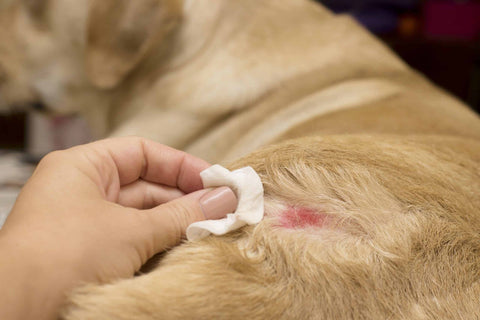Introduction
Begin by explaining the common issue of dry skin in dogs during winter. Highlight how cold weather, low humidity, and indoor heating can contribute to skin dryness. Emphasize the importance of addressing dry skin to ensure the dog’s comfort and overall health.
Understanding Dry Skin in Dogs
1. Causes of Dry Skin
- Cold Weather: Explain how cold air outside and low humidity levels indoors can strip moisture from the dog's skin.
- Indoor Heating: Discuss how indoor heating can dry out the air, exacerbating dry skin conditions.
- Frequent Bathing: Highlight how frequent bathing, especially with hot water or harsh shampoos, can remove natural oils and lead to dry skin.
- Nutritional Deficiencies: Mention the role of nutritional deficiencies, particularly a lack of essential fatty acids, in contributing to dry skin.
2. Symptoms of Dry Skin
- Flaking and Dandruff: Describe how dry skin can cause flaking and the appearance of dandruff in the dog’s coat.
- Itching and Scratching: Discuss how dry skin can lead to itching and excessive scratching, which may cause further irritation and even infection.
- Redness and Inflammation: Explain how dry skin can result in redness, inflammation, and sometimes even cracked or bleeding skin.

Prevention Tips for Dry Skin
1. Maintaining Proper Hydration
- Water Intake: Emphasize the importance of ensuring the dog has access to fresh water at all times to stay hydrated.
- Humidifiers: Suggest using humidifiers in the home to add moisture to the air, which can help prevent the dog’s skin from drying out.
2. Diet and Nutrition
- Balanced Diet: Discuss the importance of a balanced diet rich in essential fatty acids, vitamins, and minerals to support healthy skin.
- Omega-3 and Omega-6 Fatty Acids: Highlight the benefits of incorporating omega-3 and omega-6 fatty acids, found in fish oil and flaxseed oil, into the dog’s diet to improve skin health.
3. Regular Grooming
- Brushing: Explain how regular brushing helps distribute natural oils throughout the dog’s coat, preventing dryness and maintaining healthy skin.
- Bathing Routine: Discuss the importance of not over-bathing and using lukewarm water and gentle, moisturizing shampoos designed for dogs.
Treatment Options for Dry Skin
1. Topical Treatments
- Moisturizing Shampoos and Conditioners: Recommend using moisturizing shampoos and conditioners specifically formulated for dogs to hydrate the skin.
- Aloe Vera and Oatmeal: Discuss the benefits of using natural ingredients like aloe vera and oatmeal in grooming products to soothe and moisturize the skin.
2. Hydrating Sprays and Balms
- Leave-In Conditioners: Suggest using leave-in conditioners or hydrating sprays to provide extra moisture and protection to the dog’s skin and coat.
- Paw Balms: Highlight the importance of using paw balms to protect and moisturize the dog’s paw pads, which can also become dry and cracked in winter.

Home Remedies for Dry Skin
1. Coconut Oil
- Benefits: Explain the benefits of coconut oil as a natural moisturizer that can be applied directly to dry skin areas.
- Application: Provide instructions on how to apply coconut oil to the dog’s skin and coat, including recommended frequency and quantity.
2. Oatmeal Baths
- Soothing Properties: Discuss the soothing properties of oatmeal and how oatmeal baths can help alleviate itching and dryness.
- DIY Oatmeal Bath Recipe: Provide a simple recipe for creating an oatmeal bath at home, including step-by-step instructions for preparation and use.
When to Seek Veterinary Care
1. Persistent Symptoms
- Chronic Dry Skin: Explain when to seek veterinary care, such as if the dog’s dry skin persists despite home treatment or if it worsens over time.
- Underlying Health Issues: Discuss how persistent dry skin could indicate underlying health issues, such as allergies, hormonal imbalances, or infections, that require professional diagnosis and treatment.
2. Signs of Infection
- Redness and Swelling: Describe the signs of infection, such as increased redness, swelling, or pus, that necessitate immediate veterinary attention.
- Behavioral Changes: Mention how changes in behavior, such as lethargy or excessive licking, could indicate discomfort and the need for veterinary evaluation.
Long-Term Management Strategies
1. Consistent Care Routine
- Regular Monitoring: Emphasize the importance of regularly monitoring the dog’s skin and coat for signs of dryness or irritation.
- Adjusting Care Routine: Discuss the need to adjust the care routine based on seasonal changes and the dog’s specific needs.
2. Healthy Lifestyle
- Exercise and Hydration: Highlight the importance of regular exercise and adequate hydration to support overall skin health.
- Balanced Diet: Reinforce the role of a balanced diet in maintaining healthy skin and preventing dryness.
Seasonal Considerations
1. Winter-Specific Care
- Protective Clothing: Suggest using protective clothing, such as dog sweaters or coats, to shield the dog’s skin from cold, dry air.
- Indoor Humidity: Reiterate the importance of maintaining indoor humidity levels to prevent the air from becoming too dry.
2. Year-Round Skin Care
- Regular Grooming: Emphasize the importance of regular grooming and moisturizing throughout the year to maintain healthy skin.
- Seasonal Adjustments: Discuss how to adjust the grooming routine based on seasonal changes to address specific skin care needs.

Case Studies and Testimonials
1. Real-Life Experiences
- Owner Testimonials: Share testimonials from dog owners who have successfully managed their dogs’ dry skin during winter using the tips and treatments discussed.
- Positive Outcomes: Highlight the positive outcomes and benefits of diligent skin care practices during winter.
2. Case Studies
- Success Stories: Provide detailed case studies of dogs with specific skin issues that were resolved using the suggested treatments and care routines.
- Before and After: Include before and after photos to illustrate the improvements in skin and coat health.
Conclusion
Summarize the key points about dealing with a dog’s dry skin in winter, emphasizing the importance of prevention, proper treatment, and regular care. Highlight the benefits of maintaining healthy skin for the dog’s overall comfort and well-being.
Call to Action
Encourage readers to start implementing these dry skin care tips and to share their experiences or additional tips in the comments section. Invite them to subscribe to the blog for more pet care tips and advice.
